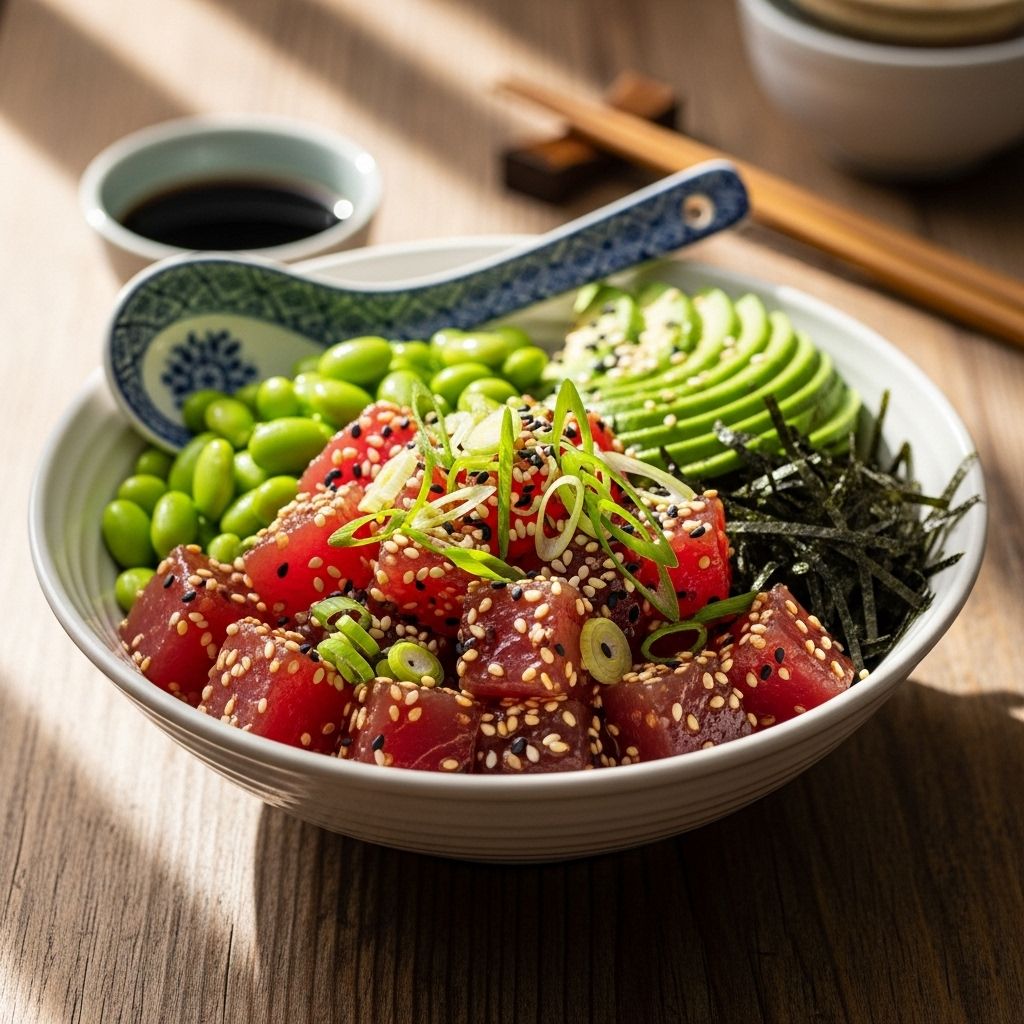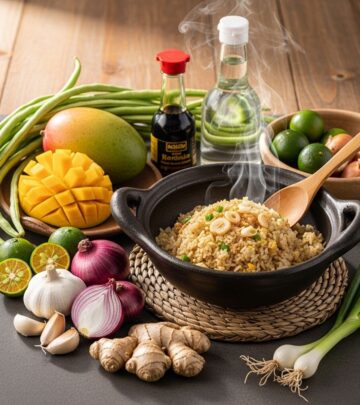Ahi Poke Recipe: 4 Easy Steps To Classic Hawaiian Tuna Salad
Discover the vibrant flavors and fresh simplicity of authentic Hawaiian ahi poke, a true seafood delicacy.

Image: HearthJunction Design Team
Ahi Poke: The Classic Hawaiian Tuna Salad
Ahi poke, a staple of Hawaiian cuisine, is a dish celebrated for its fresh, clean flavors and satisfying umami bite. With origins deeply rooted in native Hawaiian and Japanese traditions, this salad of raw, marinated tuna has taken the culinary world by storm. Whether enjoyed as a light meal, a party appetizer, or the centerpiece of a vibrant poke bowl, classic ahi poke delivers a taste of the islands in every bite.
What Is Poke?
Poke (pronounced POE-keh) means “to slice” or “to cut crosswise into pieces” in Hawaiian. Traditionally, poke consists of cubed raw fish, most commonly ahi (yellowfin tuna), tossed in a savory marinade that brings together soy sauce, sesame oil, green onions, and other seasonings. While poke is delicious on its own, it’s also commonly served over a bowl of rice, accompanied by fresh vegetables, avocado, and spicy sauces for a complete meal.
- Origins: Native Hawaiians originally ate poke as a simple preparation of sliced seafood, seasoned with sea salt, seaweed, and kukui nut.
- Evolution: Japanese and Asian influences introduced soy sauce and sesame oil, helping create the poke we know today.
- Modern Variations: Poke is endlessly customizable with different types of fish, add-ins, and toppings.
Ingredients for Classic Ahi Poke
This classic poke recipe keeps things simple, requiring just a handful of ingredients to let the flavor and texture of the fresh tuna shine. Sourcing top-quality, sashimi-grade tuna is essential, as this dish features raw fish at its heart.
- Ahi Tuna: Look for sashimi-grade yellowfin or bigeye tuna. The tuna should be bright, firm, and have a clean, ocean-like scent.
- Soy Sauce: Adds salty, umami depth to the marinade. Use a naturally brewed, good-quality soy sauce for best flavor.
- Sesame Oil: Just a splash brings toasty aroma and richness.
- Green Onions: Sliced thin for freshness and gentle onion flavor.
- Optional Garnishes: Sesame seeds (for crunch and nuttiness), chili pepper (for a touch of heat), seaweed (like ogo or wakame) for oceanic notes, and even chopped macadamia nuts for a surprising crunch.
Choosing the Right Tuna
Because ahi poke is served raw, selecting the right tuna is crucial for both safety and flavor.
- Sashimi-Grade: Always use sashimi- or sushi-grade tuna from a trusted fishmonger. This ensures the fish was handled properly for raw consumption.
- Visual Inspection: The flesh should be deep red, moist (not slimy or dry), and free of any off-odors.
- Freshness: Buy tuna on the day you plan to make poke, and keep it very cold until ready to use.
How to Make Classic Ahi Poke
Making ahi poke is incredibly quick and straightforward—no cooking required! Follow these simple steps for perfect poke every time.
- Prepare the Tuna: Using a sharp knife, cut the tuna into small, even cubes (about 1/2-inch dice). This ensures the marinade penetrates evenly and every bite is tender.
- Mix the Marinade: In a large non-reactive bowl, combine soy sauce, sesame oil, and green onions. Add any optional garnishes like sesame seeds or chili flakes at this stage.
- Toss and Marinate: Gently fold the cubed tuna into the marinade, taking care not to mash the delicate fish. Let the mixture sit for 10-15 minutes for flavors to meld. Poke can be eaten right away or chilled for a few hours.
- Finish and Serve: Sprinkle with additional green onions, sesame seeds, or chopped macadamia nuts just before serving, if desired.
Serving Suggestions
Ahi poke shines in its simplicity, but it’s also a versatile building block for other dishes. Here are some ideas for serving your poke:
- On its Own: Serve chilled as a light appetizer or snack.
- Poke Bowls: Build a hearty meal by piling poke over steamed rice and adding toppings like sliced avocado, cucumber, pickled ginger, seaweed salad, edamame, and a drizzle of spicy mayo.
- Party Platters: Present poke with taro or wonton chips for scooping.
- Lettuce Wraps: Spoon poke onto crisp butter lettuce leaves for a fresh, low-carb option.
Tips for the Best Ahi Poke
- Use the Freshest Fish: The success of poke depends on the quality of your tuna. Use it the day you buy it for best results.
- Cut Even Cubes: Uniform pieces ensure consistent texture and flavor absorption.
- Don’t Over-Marinate: Unlike ceviche, poke doesn’t rely on acid to “cook” the fish. Marinate just long enough for flavors to permeate (10-15 minutes to a few hours).
- Customize to Taste: Add more or less soy sauce, chili, or sesame oil as desired. Try swapping in sriracha or wasabi for different flavor profiles.
- Serve Cold: Keep poke chilled until serving—it tastes best and is safest when cold.
Variations on Classic Ahi Poke
While the basic poke recipe is delicious as is, feel free to experiment with add-ins and substitutions to suit your taste or what you have on hand:
- Different Fish: Try salmon, octopus, or even cooked shrimp for other options.
- Seaweed: Add chopped ogo or wakame seaweed for traditional Hawaiian flavor and chewy texture.
- Nuts: Chopped macadamia nuts or roasted peanuts add a delightful crunch.
- Spicy Kick: Mix in sriracha, wasabi, or chili-garlic sauce for heat.
- Fruits and Veggies: Diced cucumber, mango, avocado, or pickled radish balance the richness of the tuna.
Nutritional Highlights
Poke is as nutritious as it is flavorful:
| Nutrient | Per Serving* |
|---|---|
| Calories | ~120-150 kcal |
| Protein | 20-25g |
| Fat | 4-6g |
| Carbohydrates | 2-4g |
| Omega-3s | High |
*Values are approximate and depend on the recipe and serving size.
Frequently Asked Questions About Ahi Poke
Q: Can I use frozen tuna for poke?
A: Yes, but only if it’s sushi- or sashimi-grade and has been frozen specifically to be safe for raw consumption. Thaw in the refrigerator just before preparation.
Q: How long does ahi poke last in the refrigerator?
A: For best taste and safety, eat ahi poke within one day of preparation. Always store it chilled and never at room temperature.
Q: Is poke gluten-free?
A: Poke can be gluten-free if you use a gluten-free tamari or soy sauce. Check all labels on sauces and toppings to be sure.
Q: What does “ahi” mean?
A: “Ahi” refers to both yellowfin and bigeye tuna, two varieties commonly found in Hawaiian waters and prized for their rich flavor and firm texture.
Q: Can I make poke in advance?
A: Poke is best eaten shortly after preparation but can be made a few hours ahead and kept chilled. The texture of the tuna may soften the longer it sits in the marinade.
Bringing Hawaii Home: Why Ahi Poke Belongs in Your Kitchen
Ahi poke is more than just a trend—it’s a celebration of fresh seafood, simple ingredients, and the multicultural heritage of Hawaii. With just a few easily sourced ingredients and minimal preparation, you can experience the bright, clean flavors of the islands anytime. Whether you serve it as a showstopping appetizer for friends or as a satisfying lunch for yourself, ahi poke is a recipe worth mastering—and sharing.
References
Read full bio of Shinta












